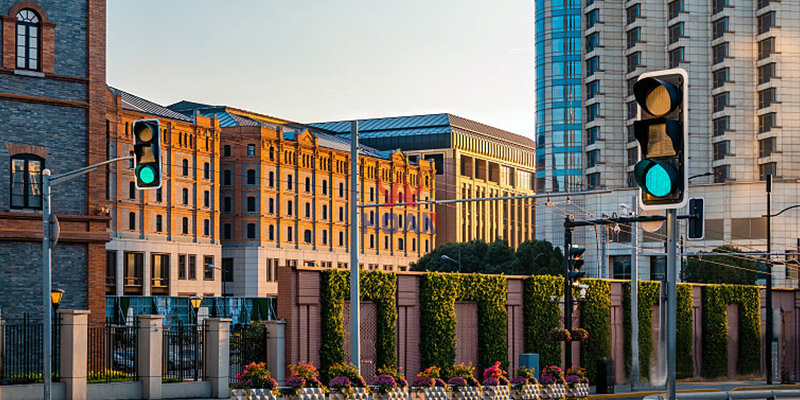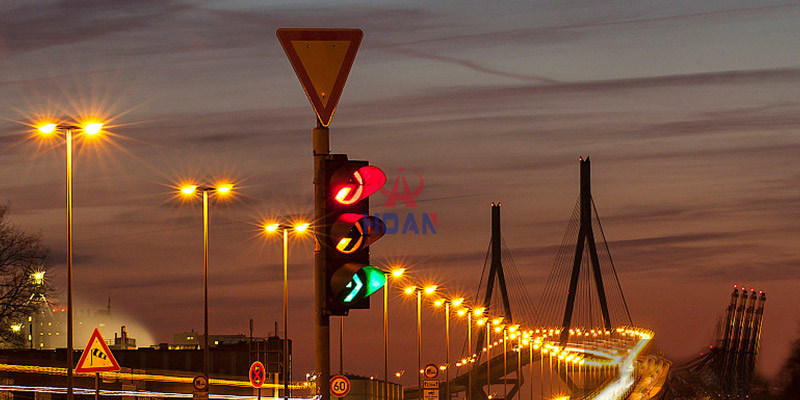Traffic lights have become an indispensable part of global road networks, appearing everywhere from major thoroughfares in bustling cities to intersections in remote rural areas. As the most fundamental traffic management infrastructure, traffic lights have a history of over a century, having undergone multiple technological innovations. Today, they are a crucial component ensuring the efficient operation of modern traffic systems. Through clear signal indications, traffic lights regulate the behaviour of road users, fundamentally reducing traffic conflicts and lowering driving risks.
At intersections without traffic lights, traffic order is often chaotic. Vehicles frequently cut in line or rush ahead, and pedestrians must remain vigilant of oncoming vehicles when crossing the road. According to relevant data, the accident rate at intersections without traffic light control is 60% higher than at those with traffic light control, posing a serious threat to the safety of road users.
Traffic signals use the orderly alternation of red, green, and yellow lights to clearly define the passage periods for vehicles and pedestrians in different directions. At a crossroads, when a green light is displayed for vehicles in one direction, vehicles and pedestrians in other directions are in a red light waiting state, effectively preventing conflicts between straight-through and left-turning vehicles, as well as between vehicles and pedestrians, allowing all traffic participants to proceed in an orderly manner.
Traffic lights control vehicle speed by setting appropriate timing intervals, forcing vehicles to slow down and wait at intersections. Drivers slow down in advance as they approach the intersection based on the traffic light status, avoiding potential collisions caused by high-speed passage through the intersection. The yellow light serves as a transition signal, alerting drivers that the light is about to turn red and prompting them to prepare for stopping in advance, thereby reducing traffic accidents caused by running red lights.
Pedestrian and non-motorised vehicle signals provide dedicated crossing times for pedestrians, cyclists, and other vulnerable groups. When the pedestrian crossing light turns green, motor vehicles are prohibited from passing, allowing pedestrians to cross the road safely. This feature significantly reduces the likelihood of collisions between pedestrians and motor vehicles, ensuring the safety of vulnerable road users.

Intelligent traffic lights are equipped with cameras, sensors, and other devices that can monitor real-time traffic flow and pedestrian flow at intersections and dynamically adjust signal durations. During peak traffic hours, it extends the green light duration on main roads to reduce vehicle congestion; during off-peak hours, it shortens waiting times to avoid prolonged idling, thereby lowering the risk of rear-end collisions and other accidents.
Modern traffic signals use high-brightness LED light sources with strong luminous intensity, ensuring clear visibility even under harsh weather conditions such as strong sunlight, heavy rain, or fog. Additionally, the signal housings feature anti-glare designs to prevent direct light from shining into drivers' eyes, reducing visual interference and enabling drivers to accurately identify signal status.
Many traffic lights are equipped with countdown displays, allowing drivers to anticipate signal changes in advance and smoothly decelerate or accelerate through intersections within legal limits. Furthermore, the traffic light violation detection system at intersections effectively deter dangerous behaviours such as running red lights or rushing through yellow lights, encouraging drivers to comply with traffic rules.
Urban main road intersections have high traffic volume and diverse vehicle types. Traffic signal lights precisely coordinate traffic flow in different directions to prevent traffic congestion and collisions. During peak hours in the morning and evening, signal lights flexibly adjust timing based on changes in traffic volume, enabling vehicles from all directions to pass orderly and significantly reducing cross-conflicts.
During peak hours for school commuting and hospital visits, traffic lights may activate pedestrian priority modes or temporarily adjust timing. For example, traffic lights near schools extend pedestrian green light durations during dismissal times to ensure student safety when crossing the street. In these areas, traffic lights are often used in conjunction with speed bumps and speed limit signs to further reduce driving risks.
Traffic lights at highway toll stations and ramp interchanges effectively control vehicle entry/exit speeds to prevent collisions with mainline traffic. Ramp traffic lights typically use an ‘stop on red, go on green’ intermittent release mode to prevent multiple vehicles from continuously merging into the mainline, causing congestion or rear-end collisions.
Traffic lights at tunnel entrances and exits control the flow of vehicles entering and exiting the tunnel to prevent congestion inside the tunnel. Additionally, the changing lights help drivers gradually adapt to the transition between light and dark, reducing blind spots caused by sudden visual changes and lowering the likelihood of accidents.
Traffic signal lights coordinate with stop lines, directional arrows, and other markings to clearly define vehicle waiting and driving zones. For example, vehicles must wait behind the stop line for the signal light, while directional arrows indicate the driving direction. Additionally, signal lights coordinate with ‘speed limit’ and ‘yield’ signs, ensuring drivers comply with both signal lights and other traffic rules.
Traffic lights work in tandem with electronic police systems and surveillance cameras to capture violations such as running red lights or failing to follow lane markings in real time. By penalising such violations, drivers are incentivised to adhere to proper driving behaviour, further ensuring traffic order and safety at intersections.
Some cities have integrated traffic light data into in-vehicle navigation or vehicle-to-infrastructure communication systems, providing drivers with advance notice of the status of upcoming traffic lights and recommended speeds. Drivers can adjust their vehicle speed based on this information, smoothly pass through intersections, reduce sudden braking and aggressive driving, and lower the risk of accidents.

A crossroads in a certain city was previously a high-accident area due to heavy traffic flow and unreasonable signal timing, resulting in over 30 traffic accidents annually. After upgrading to intelligent traffic signals and optimising signal timing, the intersection adjusted signal durations in real-time based on traffic flow monitoring. Within a year, traffic accidents decreased by 55%, with rear-end collisions reducing by 60% and pedestrian-vehicle conflicts dropping to zero.
A rural intersection previously lacked traffic signals, with agricultural vehicles, private cars, and pedestrians sharing the road, resulting in several traffic accidents annually. After installing simple traffic signals, vehicles now follow the signals in an orderly manner, and pedestrians have safer crossing options. Villagers commented, ‘Now we don't have to look left and right when crossing the road, and driving feels safer.’ Within six months of installing the signals, no major accidents occurred at the intersection.
In the future, traffic signals will utilise 5G, IoT, and other technologies to communicate in real-time with vehicles, preemptively sending signal changes to vehicles. By establishing a ‘green wave’ travel mode, the time vehicles spend waiting at intersections will be reduced, further lowering the risk of accidents.
Using AI cameras, traffic signal lights can accurately identify different types of road users, such as pedestrians, wheelchair users, and children, and automatically extend the pedestrian green light time. This feature effectively prevents ‘ghost head’ accidents and provides safer protection for vulnerable road users.
Solar-powered signal lights will be more widely adopted in remote areas, ensuring traffic safety while reducing energy consumption. Additionally, these traffic lights have an automatic fault alarm function, enabling timely detection and resolution of equipment issues, thereby reducing safety hazards caused by equipment failure.
Traffic lights, through their core functions of clearly defining right-of-way, controlling vehicle speed, and protecting vulnerable road users, as well as technological upgrades and coordination with other facilities, comprehensively reduce driving risks in various scenarios, serving as the ‘invisible guardians’ of road safety. Traffic management authorities should continue to optimise traffic light timing and technological upgrades to enhance the safety and effectiveness of traffic signals. At the same time, we urge all drivers to strictly adhere to traffic light rules to jointly maintain traffic order. For more information on intelligent traffic signal solutions, please visit our official website or call our consultation hotline. Let us work together to enhance road safety standards.